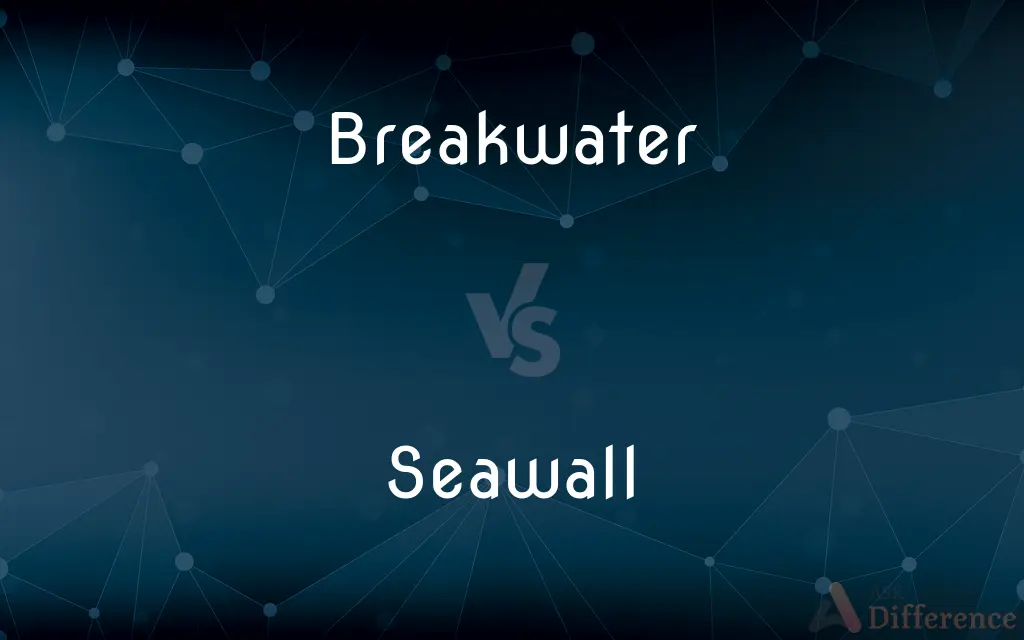Breakwater vs. Seawall — What's the Difference?
By Tayyaba Rehman & Maham Liaqat — Updated on March 21, 2024
A breakwater is a structure built offshore to protect a coast or harbor from the force of waves, while a seawall is constructed parallel to the shore to prevent erosion and flooding.

Difference Between Breakwater and Seawall
Table of Contents
ADVERTISEMENT
Key Differences
Breakwaters are offshore structures designed to absorb and dissipate the energy of waves before they reach the shoreline, thereby reducing erosion and providing safe harborage. They are often submerged or partially submerged and can be built from various materials such as rock, concrete, or steel. On the other hand, seawalls are built directly on the shore, acting as barriers to prevent the direct impact of waves on the land. Seawalls are typically more visible and can significantly alter the appearance of the coastline.
Seawalls are engineered to resist the full force of waves, often reflecting the energy back to sea, which can sometimes increase erosion in adjacent areas. They are crucial for protecting coastal infrastructure and populated areas from storm surges and high waves. Conversely, breakwaters, by breaking the force of waves, create calmer waters behind them, making them essential for the protection of harbors and the creation of safe anchorage areas for boats and ships.
Breakwaters can extend quite a distance from the shore and may form part of a larger system of coastal defense that includes seawalls and other structures. Their design and placement are critical in shaping wave patterns and sediment distribution along the coast. Seawalls, in contrast, require careful consideration of height and construction material to effectively protect against wave overtopping and to withstand the pressure exerted by storm surges.
The environmental impact of these structures differs significantly. Breakwaters can alter local ecosystems by changing sediment dynamics and water flow, potentially harming marine habitats. Seawalls can have a similar effect, particularly by preventing the natural landward migration of beaches, leading to a loss of natural habitat and a reduction in beach size.
In terms of maintenance and longevity, both structures face challenges from the relentless power of the sea. Seawalls may require more frequent repairs due to their constant exposure to wave action, whereas breakwaters, especially those well-designed and constructed from durable materials, may enjoy longer intervals between maintenance. However, both types of structures are susceptible to damage from severe storms and the long-term effects of sea-level rise.
ADVERTISEMENT
Comparison Chart
Location
Offshore, may be partially submerged
Built directly on the shore
Primary Function
Protects coasts/harbors from waves
Prevents erosion and flooding
Impact on Waves
Absorbs/dissipates wave energy
Reflects wave energy back to the sea
Construction Materials
Rock, concrete, steel
Concrete, steel, sometimes rock
Environmental Impact
Can alter sediment dynamics and water flow
Prevents natural migration of beaches, may increase erosion
Compare with Definitions
Breakwater
Aids in coastal defense alongside other structures.
The coastal defense system includes a breakwater and a seawall to protect the shoreline.
Seawall
A wall built on the edge of the coastline to prevent erosion and flooding.
The seawall along the promenade has been reinforced to withstand higher tides.
Breakwater
A structure designed to create calmer waters behind it.
Sailors seek anchorage behind the breakwater for protection against strong winds.
Seawall
Reflects waves back to sea, which can increase erosion in other areas.
The reflection of waves from the seawall has caused increased erosion downstream.
Breakwater
A barrier built offshore to protect a shore or harbor from the force of waves.
The new breakwater has significantly reduced the amount of wave damage to the marina.
Seawall
Acts as a barrier between land and waves.
The newly constructed seawall has effectively prevented beach erosion in the area.
Breakwater
Often made from rock, concrete, or steel.
The breakwater's rock construction has withstood several severe storms.
Seawall
Made from materials like concrete or steel for durability.
The steel-reinforced concrete seawall is designed to last for decades.
Breakwater
Can be partially submerged depending on the design.
The partially submerged breakwater is a popular spot for fishing.
Seawall
Requires maintenance to handle the relentless sea pressure.
Regular inspections ensure the seawall remains effective against storm surges.
Breakwater
A barrier that protects a harbor or shore from the full impact of waves.
Seawall
A seawall (or sea wall) is a form of coastal defence constructed where the sea, and associated coastal processes, impact directly upon the landforms of the coast. The purpose of a sea wall is to protect areas of human habitation, conservation and leisure activities from the action of tides, waves, or tsunamis.
Breakwater
A construction in or around a harbour designed to break the force of the sea and to provide shelter for vessels lying inside.
Seawall
An embankment to prevent erosion of a shoreline.
Breakwater
(nautical) A low bulkhead across the forecastle deck of a ship which diverts water breaking over the bows into the scuppers.
Seawall
A coastal defence in the form of a wall or an embankment.
Breakwater
(on beaches) A wooden or concrete barrier, usually perpendicular to the shore, intended to prevent the movement of sand along a coast.
Seawall
A protective structure of stone or concrete; extends from shore into the water to prevent a beach from washing away
Breakwater
Any structure or contrivance, as a mole, or a wall at the mouth of a harbor, to break the force of waves, and afford protection from their violence.
Breakwater
A protective structure of stone or concrete; extends from shore into the water to prevent a beach from washing away
Common Curiosities
What is a breakwater?
A breakwater is an offshore structure designed to protect the shore or harbor from the impact of waves by absorbing and dissipating their energy.
Can breakwaters and seawalls help prevent coastal erosion?
Yes, both structures are designed to protect coastlines, with breakwaters reducing wave energy and seawalls preventing direct wave impact on the shore.
What is a seawall?
A seawall is a wall built on the coast to prevent erosion and flooding by acting as a barrier against waves.
What materials are used to build breakwaters and seawalls?
Common materials include rock, concrete, and steel, with specific choices depending on durability needs and environmental considerations.
How do breakwaters and seawalls differ in location?
Breakwaters are usually built offshore, sometimes partially submerged, while seawalls are constructed directly on the shoreline.
Can seawalls increase erosion in some areas?
Yes, by reflecting wave energy back to sea, seawalls can sometimes lead to increased erosion in adjacent areas.
How do breakwaters protect harbors?
By dissipating wave energy, breakwaters create calmer waters behind them, making harbors safer for boats and ships.
Do breakwaters affect marine ecosystems?
Yes, breakwaters can alter sediment dynamics and water flow, potentially impacting local marine habitats.
Are breakwaters visible above water?
Some breakwaters are visible above water, but many are partially submerged, depending on their design.
What is the environmental impact of a seawall?
Seawalls can prevent the natural migration of beaches and lead to habitat loss and reduced beach size.
Why are seawalls constructed?
Seawalls are constructed to protect populated areas and infrastructure from storm surges, high waves, and erosion.
How do seawalls and breakwaters contribute to coastal defense?
They form part of a coastal defense strategy by protecting against erosion, flooding, and the impact of storms.
What considerations are important in the design of breakwaters and seawalls?
Design considerations include materials, environmental impact, and the specific coastal challenges they are meant to address.
Can the construction of a breakwater affect nearby beaches?
Yes, by altering wave patterns and sediment distribution, breakwaters can affect the shape and size of nearby beaches.
How often do breakwaters and seawalls require maintenance?
Maintenance frequency depends on construction materials and exposure to wave action, with seawalls generally requiring more frequent upkeep.
Share Your Discovery

Previous Comparison
Tender vs. Contract
Next Comparison
Transponder vs. TransducerAuthor Spotlight
Written by
Tayyaba RehmanTayyaba Rehman is a distinguished writer, currently serving as a primary contributor to askdifference.com. As a researcher in semantics and etymology, Tayyaba's passion for the complexity of languages and their distinctions has found a perfect home on the platform. Tayyaba delves into the intricacies of language, distinguishing between commonly confused words and phrases, thereby providing clarity for readers worldwide.
Co-written by
Maham Liaqat













































